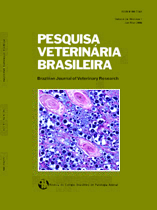 |
|
|
|
Year 2014 - Volume 34, Number 3
|

|
The seasonal and ovarian status effects on in vitro production of domestic cat embryos between Equator and Tropic of Capricorn, 34(3):277-280
|
ABSTRACT.- Martins L.R., Fernandes, C.B., Villaverde A.I.S.B., Landim-Alvarenga F.C. & Lopes M.D. 2014. The seasonal and ovarian status effects on in vitro production of domestic cat embryos in a region between Equator and Tropic of Capricorn. Pesquisa Veterinária Brasileira 34(3):277-280. Laboratório de Reprodução Animal, Curso de Medicina Veterinária, Universidade Federal de Mato Grosso, Av. Alexandre Ferronato 1200, Sinop, MT 78557-267, Brazil. E-mail: lirigatto@yahoo.com.br
From the Tropic of Capricorn to Equator, the seasonality of domestic cat is known to be absent, i.e., these animals are considered non-seasonal breeders at these regions. We hypothesized that this particularity might have some influence on in vitro embryo production. The aim of this experiment was to determine the percentage of cleavage and morulae and blastocyst formation produced from oocytes recovered from queen ovaries of three distinct status - follicular, luteal or inactive - during two different reproductive seasons experienced by cats in southeast of Brazil (22°53’09” S and 48°26’42” W) – non breeding season (NBS), comprehending January to March; and breeding season (BS), August to October. Thirty queens were neutered. Ovaries were classified according to their status and were sliced in PBS for cumulus oocyte complex (COC) releasing. Grade I COC were washed three times in H-MEM supplemented with BSA, glutamine, sodium pyruvate, cysteine, streptomycin and penicillin. Oocytes were incubated in groups of 20-30 in 400µL of DMEM supplemented with FSH, LH, estradiol, IGF-I and basic fibroblast growth factor under mineral oil for 30 or 36 hours at 38°C in humidified environment of 5% de O2, 5% CO2 and 90% N2. COC were fertilized in Ham’s F-10 medium supplemented with BSA, cysteine, pyruvate and streptomycin/penicillin (culture medium) with fresh semen selected through swim up technique. Eighteen hours later, the presumptive zygotes were denuded, the percentage of cleavage was determined and every 10 zygotes were transferred to 100mL drops of culture medium for culture during three days. After 72 hours of culture the percentage of morulae formation was evaluated and these structures were transferred to drops of the same culture medium. At the eighth day of culture blastocyst formation was analyzed. During NBS, from a total of 272 (inactive), 162 (luteal) and 134 (follicular) fertilized oocytes, the percentage of cleaved zygotes, morulae and blastocysts derived from inactive ovaries were 24.63, 16.54 and 8.09 respectively; for those derived from luteal ovaries, the percentage was 21.6, 12.96 and 8.64, and for those from follicular ovaries, they were 24.62, 16.41 and 8.21. Considering BS, from a total of 102 (inactive), 198 (luteal) and 86 (follicular) fertilized oocytes, the relative frequency (%) of cleaved zygotes, morulae and blastocysts derived from inactive ovaries were 64.7, 41.17 and 23.53 respectively; for those derived from luteal ovaries, the percentage was 64.14, 40.41 and 23.73, and for those from follicular ovaries, they were 63.95, 39.54 and 24.41. The results of this experiment demonstrate that no statistically significant difference (P<0.05) was verified in the frequency of cleaved embryos and morulae and blastocyst formation when comparing the three ovarian conditions in the same season. However the breeding season presented better results considering cleavage and morulae and blastocyst formation. |
| |
|
|
| |
|
 |